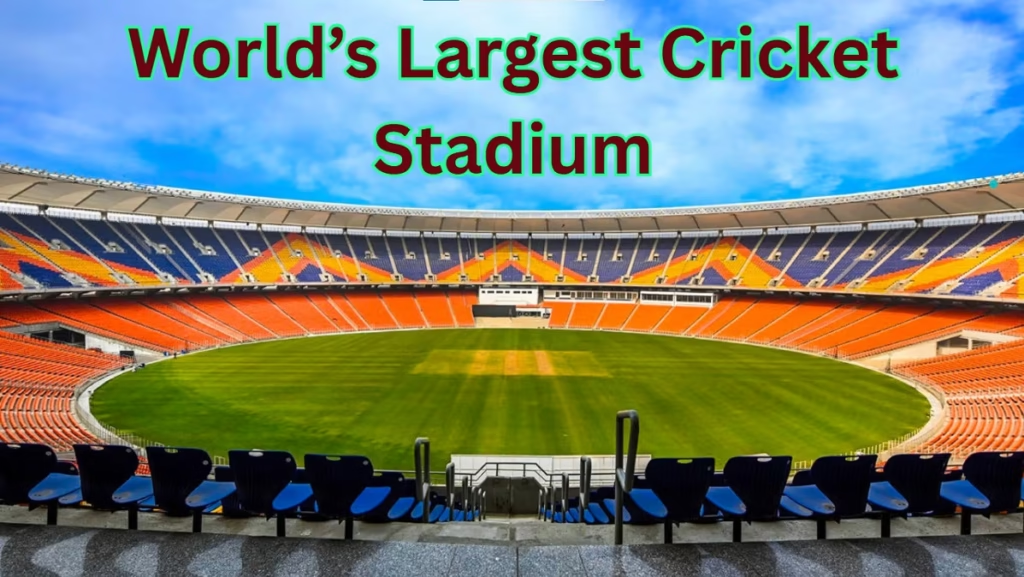
The World Biggest Cricket Stadium: Narendra Modi Stadium – A Monument to Cricket’s Grandeur
Cricket is more than a sport in India; it’s a cultural phenomenon that unites millions. At the heart of this passion lies the World Biggest Cricket Stadium, the Narendra Modi Stadium in Ahmedabad, Gujarat. With a staggering seating capacity of 132,000, this architectural marvel stands as a testament to cricket’s global appeal and India’s commitment to elevating the sport’s infrastructure. This article explores the history, features, significance, and legacy of the World Biggest Cricket Stadium, delving into why it’s a beacon for cricket enthusiasts worldwide.
A Brief History of the World Biggest Cricket Stadium
The World Biggest Cricket Stadium, originally known as the Sardar Patel Stadium, was first established in 1983. Located in Motera, Ahmedabad, it served as a prominent venue for domestic and international cricket matches. However, in 2015, the Gujarat Cricket Association (GCA) decided to demolish the old structure to make way for a modern, state-of-the-art facility. The vision was clear: to create the World Biggest Cricket Stadium that could rival global sporting arenas in both capacity and amenities.
Reconstruction began in 2016, with the project spearheaded by Larsen & Toubro and designed by the renowned architectural firm Populous. Completed in February 2020 at an estimated cost of ₹800 crore (US$95 million), the revamped stadium was renamed the Narendra Modi Stadium in honor of India’s Prime Minister, who also served as the president of the GCA from 2009 to 2014. The World Biggest Cricket Stadium was inaugurated during the Namaste Trump event in 2020, attended by over 125,000 spectators, marking its grand entry onto the global stage.
Architectural Brilliance of the World Biggest Cricket Stadium
The World Biggest Cricket Stadium is a masterpiece of modern architecture. Spanning 63 acres, it boasts a pillar-less design that ensures unobstructed views for every spectator. The circular layout enhances the fan experience, creating an immersive atmosphere where the roar of the crowd reverberates across the stands. The stadium’s lightweight PTFE membrane roof is earthquake-resistant, a critical feature given Ahmedabad’s seismic zone.
Key features of the World Biggest Cricket Stadium include:
- Seating Capacity: With 132,000 seats, it surpasses the Melbourne Cricket Ground (MCG), which holds 100,024, making it the World Biggest Cricket Stadium by capacity.
- LED Lighting: Unlike traditional floodlights, the stadium uses energy-efficient LED lights, ensuring optimal visibility for night matches and reducing environmental impact.
- Drainage System: A high-tech drainage system clears rainwater within 30 minutes, minimizing match delays—a crucial feature for hosting international events.
- Corporate Boxes and Clubhouse: The stadium has 76 corporate boxes, each accommodating 25 people, and a 55-room clubhouse for premium hospitality.
- Practice Facilities: Two practice grounds, 11 center pitches, and an indoor cricket academy with dormitories for 40 athletes make it a hub for player development.
- Additional Amenities: An Olympic-sized swimming pool, four dressing rooms, and food courts in each spectator stand elevate the experience for players and fans alike.
The World Biggest Cricket Stadium is not just a venue; it’s a self-contained ecosystem designed to cater to every aspect of the cricketing experience.
Major Events Hosted at the World Biggest Cricket Stadium
Since its reopening in 2020, the World Biggest Cricket Stadium has hosted a slew of high-profile events, cementing its status as a global cricketing hub. Some notable moments include:
- 2023 Cricket World Cup: The World Biggest Cricket Stadium hosted five matches, including the opening game, the high-octane India vs. Pakistan clash, and the final, drawing massive global viewership.
- IPL Finals: As the home ground for the Gujarat Titans, the stadium hosted the 2022, 2023, and 2025 Indian Premier League (IPL) finals, showcasing its ability to handle large-scale T20 events.
- Namaste Trump (2020): The World Biggest Cricket Stadium welcomed US President Donald Trump and Indian Prime Minister Narendra Modi, with 125,000 attendees creating an unforgettable spectacle.
- Coldplay Concert (2025): The British rock band performed two shows on January 25 and 26, 2025, as part of their Music of the Spheres World Tour, proving the stadium’s versatility beyond cricket.
- First Test Match (2021): The World Biggest Cricket Stadium hosted its inaugural Test match, a day-night game between India and England, marking a historic moment.
These events highlight the World Biggest Cricket Stadium’s ability to host diverse, high-stakes occasions, from sporting triumphs to cultural milestones.
Why the World Biggest Cricket Stadium Stands Out
The World Biggest Cricket Stadium is more than just a venue with a massive capacity. Its significance lies in its ability to blend tradition with innovation. India’s deep-rooted love for cricket is reflected in the stadium’s design, which prioritizes fan comfort and player performance. The World Biggest Cricket Stadium has set a new benchmark for sports infrastructure, inspiring other nations to elevate their facilities.
The stadium’s strategic location in Ahmedabad, with a metro line at one of its four entry points, ensures accessibility for fans. Its eco-friendly initiatives, such as LED lighting and efficient drainage, align with global sustainability trends. The World Biggest Cricket Stadium also serves as a training hub, with its indoor academy fostering the next generation of cricketers.
Economic and Cultural Impact of the World Biggest Cricket Stadium
The World Biggest Cricket Stadium has had a profound impact on Ahmedabad and Gujarat. Economically, it has boosted tourism, created jobs, and stimulated local businesses during major events. The influx of international visitors for matches and concerts has put Ahmedabad on the global map, reinforcing its status as a vibrant cultural and sporting hub.
Culturally, the World Biggest Cricket Stadium embodies India’s passion for cricket. It’s a place where fans from diverse backgrounds come together to celebrate their shared love for the sport. The electric atmosphere during matches, especially India-Pakistan encounters, is unmatched, making the World Biggest Cricket Stadium a pilgrimage site for cricket lovers.
The Future of the World Biggest Cricket Stadium
As cricket continues to grow globally, the World Biggest Cricket Stadium is poised to play a pivotal role. Plans are underway to enhance its facilities further, with potential expansions to accommodate even more fans. The Andhra Cricket Association’s announcement in 2025 to build a stadium in Amravati with a capacity exceeding 132,000 poses a potential challenge, but as of now, the Narendra Modi Stadium remains the World Biggest Cricket Stadium.
The stadium is also exploring hosting more non-cricketing events, such as international concerts and multi-sport tournaments, to maximize its utility. With its world-class infrastructure, the World Biggest Cricket Stadium is set to remain a cornerstone of global sports for decades to come.
Conclusion
The Narendra Modi Stadium, the World Biggest Cricket Stadium, is a symbol of cricket’s enduring legacy and India’s ambition to lead the sporting world. Its colossal capacity, cutting-edge facilities, and rich history make it a must-visit destination for fans and a benchmark for stadiums worldwide. Whether it’s hosting a thrilling IPL final or a global concert, the World Biggest Cricket Stadium continues to redefine what a sporting venue can achieve. As cricket evolves, this iconic arena will remain at the forefront, uniting fans and creating memories that last a lifetime.
FAQs About the World Biggest Cricket Stadium
Q1: What is the World Biggest Cricket Stadium?
The World Biggest Cricket Stadium is the Narendra Modi Stadium in Ahmedabad, Gujarat, India, with a seating capacity of 132,000.
Q2: When was the World Biggest Cricket Stadium built?
The original Sardar Patel Stadium was built in 1983 but was demolished in 2015. The reconstructed Narendra Modi Stadium, now the World Biggest Cricket Stadium, was completed in February 2020.
Q3: What makes the World Biggest Cricket Stadium unique?
The World Biggest Cricket Stadium features a pillar-less design, LED lighting, an advanced drainage system, 76 corporate boxes, and an indoor cricket academy, making it a state-of-the-art facility.
Q4: What major events has the World Biggest Cricket Stadium hosted?
The World Biggest Cricket Stadium has hosted the 2023 Cricket World Cup, IPL finals, the Namaste Trump event, and Coldplay concerts in 2025.
Q5: Is the World Biggest Cricket Stadium only for cricket?
No, the World Biggest Cricket Stadium is a multi-purpose venue that hosts concerts, cultural events, and potentially other sports, showcasing its versatility.
Q6: How does the World Biggest Cricket Stadium compare to the Melbourne Cricket Ground?
The Narendra Modi Stadium, the World Biggest Cricket Stadium, has a capacity of 132,000, surpassing the MCG’s 100,024, though the MCG remains iconic for its history.
Q7: What is the future of the World Biggest Cricket Stadium?
The World Biggest Cricket Stadium is expected to host more international events and may see further expansions to maintain its status as the largest cricket venue globally.






